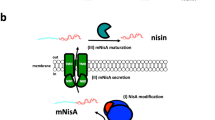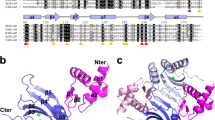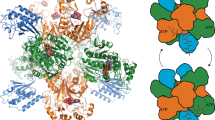Abstract
BACTERIAL synthesis of polypeptide antibiotics occurs during the exponential phase or early stationary phase of growth1. The compounds synthesized vary in molecular weight from about 350 to 14,000 (ref. 2); nisin, produced by Streptococcus lactis, has a molecular weight estimated at 7,000 (ref. 3). This brings nisin into the class of small proteins rather than polypeptides because insulin, for example, has a molecular weight of 6,000 (ref. 4). The biosynthesis of nisin was studied recently using washed cell suspensions of S. lactis (NCDO 497) (ref. 5). Inhibitors of protein synthesis and actinomycin D, which inhibits mRNA synthesis, also inhibited nisin synthesis, which suggested that this process resembled the ribosomal mechanism of protein synthesis.
This is a preview of subscription content, access via your institution
Access options
Subscribe to this journal
Receive 51 print issues and online access
$199.00 per year
only $3.90 per issue
Buy this article
- Purchase on Springer Link
- Instant access to full article PDF
Prices may be subject to local taxes which are calculated during checkout
Similar content being viewed by others
References
Abraham, E. P., Newton, G. G. F., and Warren, S. C., in Biogenesis of Antibiotic Substances (edit. by Vanek, Z., and Hostalek, Z.), 169 (Academic Press, London, 1965).
Bodansky, M., and Perlman, D., Nature, 204, 840 (1964).
Cheeseman, G. C., and Berridge, N. J., Biochem. J., 71, 185 (1959).
Sanger, F., Science, 129, 1340 (1959).
Hurst, A., J. Gen. Microbiol., 44, 209 (1966).
Hurst, A., J. Gen. Microbiol., 45, 666 (1966).
Dawes, E. A., Quantitative Problems in Biochemistry, 196 (E. and S. Living stone, London, 1963).
Hurst, A., Proc. Intern. Cong. Microbiol., 209 (Moscow, 1966).
Hirsch, A., J. Gen. Microbiol., 5 (1951).
Szabo, G., Vitalis, S., and Bekesi, I., J. Gen. Microbiol., 44, 5 (1966).
Moore, L. D., and Shockman, G. D., Fed. Proc., 25, 582 (1966).
Hurst, A., and Taylor, D. R., Nature, 207, 438 (1965).
Raina, A., and Cohen, S. S., Proc. U. S. Nat. Acad. Sci., 55, 1587 (1966).
Halvorson, H. O., in Function and Structure in Microorganisms (edit. by Pollock, M. R., and Richmond, M. H.), 343 (Cambridge University Press, 1965).
Spizizen, J., in Spores III (edit. by Campbell, L. L., and Halvorson, H. O.), 125 (Amer. Soc. Microbiol., 1965).
Woodruff, H. B., in Biochemical Studies of Anti-Microbial Drugs (edit. by Newton, B. A., and Reynolds, P. E.), 22 (Cambridge University Press, 1966).
Tombs, M. P., Anal. Biochem., 13, 121 (1965).
Author information
Authors and Affiliations
Rights and permissions
About this article
Cite this article
HURST, A. Function of Nisin and Nisin-like Basic Proteins in the Growth Cycle of Streptococcus lactis. Nature 214, 1232–1234 (1967). https://doi.org/10.1038/2141232a0
Received:
Revised:
Issue Date:
DOI: https://doi.org/10.1038/2141232a0
This article is cited by
-
Evaluating the antimicrobial activity of Nisin, Lysozyme and Ethylenediaminetetraacetate incorporated in starch based active food packaging film
Journal of Food Science and Technology (2014)
-
Natural Antimicrobials ε-Poly-l-lysine and Nisin A for Control of Oral Microflora
Probiotics and Antimicrobial Proteins (2009)
Comments
By submitting a comment you agree to abide by our Terms and Community Guidelines. If you find something abusive or that does not comply with our terms or guidelines please flag it as inappropriate.



